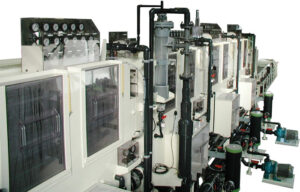DES LINE DEVICE
This is an explanation of the “DES line device” that is often heard in the photo etching industry.
There are few websites that list not only the features but also the strengths and weaknesses, so we would appreciate it if you could refer to this page. Of course, we can also manufacture this device.
What is DES Line?
This is an all-in-one line device with developing, etching, and stripping functions. The point is that these three processes can be performed as a single device.
The origin of the name comes from three initials: Developing, Etching, and Stripping.
Let’s take a look at each feature.
Developing
In photofabrication, developing is the post-exposure process.
Dissolve and remove the photoresist other than those required and form a pattern image of the photoresist.
There is a “soaking method” of immersion in developer and a “spray method” of spraying, and there is a common use of spray methods in terms of supply efficiency of developer.
Immediately after the developing, a set of heating treatments called post-baking are carried out.
The post-baking box hardens the photoresist, which results in resistance to etching fluid in the next process and improves adherence to substrates.
Etching
Etching is a post-developing process.
While continuously transporting using etchants suitable for metal materials (products), a large amount of etching is performed uniformly by the spray method.
As the management of etchant is important, an etchant autoanalyzer is installed as a supplementary facility, and various chemicals are automatically supplied based on the feedback of each component analysis to maintain a constant etching rate.
Stripping
Stripping is the post-etching process.
After etching, dissolve the unnecessary photoresist film.
Depending on the type of photo registry, sodium hydroxide heated around 40 to 80℃ or 100℃ is commonly used.
In the case of special resist, mixed solvents such as xylene, alcohols and ketones may be used.
If the product cannot be stripped by immersion, physical force such as brush or spray is applied to the product. Immediately after stripping, De-ionized water cleaning, drying, and rust prevention are performed as a set.
DES Line’s Advantages and disadvantages
DES Line’s Advantages
- the unit’s area becomes smaller.
- Since there is only one each inlet (LD) and outlet (ULD), it can be operated by the minimum number of people.
- It’s cheaper than purchasing three separate machines.
DES Line’s disadvantages
- The tact time of the device is rate-determining in the slowest process.
- When a product defect occurs, it is difficult to determine which process is the cause.
- It is not suitable for various kinds of products whose processing conditions change significantly.
- It is not suitable for research and development purposes that assess and select types of the photoresist or film thickness.
Based on the above,
For example, it can be said that it is a device for mass production that has a fixed usage such as a line for thin film circuit boards, and the composition and usage conditions of photoresist, developer, etching solution, and stripping solution are fixed.
Our DES line device
Specification example of Developing, Etching, Stripping combined device
|
Item
|
Contents
|
|---|---|
| Use | For Thin Film Etching |
| Work piece material |
Stainless Steel, Copper, Aluminum
|
| Work piece width |
Width 600mm
|
| Major chemicals |
|
| Key features |
|

Features of DES Line
It is an automatic equipment that combines all three functions such as developing, etching, and stripping.
If the product material, chemicals used, processing time, etc. are clear, the equipment can be manufactured in the smallest area and at a low price.
Since both acid and alkali are used in one device, we design and manufacture safety measures thoroughly.



